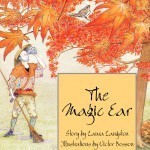Laura Langston's Blog, page 42
February 19, 2014
Overheard This Week
 Achoo. Hack, Hack. Sniffle. Moan.
Achoo. Hack, Hack. Sniffle. Moan.
Yes, it’s cold season. I fought the good fight for about three weeks, battling a sore throat with Echinacea spray, drinking lots of fluids, staying home and resting. I was determined to be well for a day of author talks at Shaughnessy Elementary School in Vancouver. And I was. The day went well. The kids were fabulous. The sore throat receded. I felt pretty good. But four days after I came back to Victoria, the cold hit. And it’s a doozy. I haven’t had one this bad in years.
My normal tendency is to push through, continue writing, keep up the routine. And I tried. I really did. But this frigus et caput (Latin for head cold – way more descriptive than common cold, don’t you think?) will have none of it. Sitting at the computer is too hard on my eyes. My body aches. My concentration is shot.
So I’ve been tucked up on the couch, a cup of rose hip tea beside me, Team Sheltie at my feet. I’ve been resting, reading, and thinking. Taking notes on One Good Deed, my work-in-progress, when I feel inclined. And here’s a funny thing – this cold seems to have shut down the logical, analytical left side of my brain. The ‘that-wouldn’t-work-editor’ is flat lined. The only part of me that’s thinking (and not too clearly at that) is the ‘why not?’ part of me.
Yesterday I had a thought, admittedly a feverish and fuzzy one, about a possible plot twist in my current WIP. It was the kind of twist that would force the protagonist to do something so far out of her comfort zone it would either leave her guilt-riddled forever, or force her to grow and change the way she needs to in this particular story. It would push my boundaries too because it’s a scene I’m not sure I’d be comfortable writing. Will I run with it? I don’t know. I’ll have to wait until the mucus clears. In the meantime, I’m writing down all the weird and wacky thoughts that float my way. Drinking lots of tea. And cuddling Team Sheltie.
February 12, 2014
Books Bloom with a Sense of Place
 I had a writing lesson from the garden the other day. If you want to get technical, it wasn’t directly from the garden, but it was garden-related. I like to force bulbs at this time of year. I love having blooms in the middle of winter. This year I had a left over pre-packaged kit of paper whites. They were destined to be a Christmas gift, but at the last minute another gift was switched in and I decided to keep them.
I had a writing lesson from the garden the other day. If you want to get technical, it wasn’t directly from the garden, but it was garden-related. I like to force bulbs at this time of year. I love having blooms in the middle of winter. This year I had a left over pre-packaged kit of paper whites. They were destined to be a Christmas gift, but at the last minute another gift was switched in and I decided to keep them.
I set three bulbs into a regular garden pot and surrounded them with the premade soilless mix that came in the kit. That pot went on my kitchen windowsill. I nestled two other bulbs in a vase filled with colored stones and water. I put the vase in my living room on a cabinet across from the front door. I figured they’d be a great welcome home as they sprouted and bloomed.
The two bulbs in the living room showed signs of life within a few days. Tiny green sprouts shot out of the bulbs, sturdy and purposeful. The three bulbs in the kitchen languished. I made sure they had just enough (but not too much) water. I attempted to keep the temperature cool. I hovered for a bit and then turned a blind eye. One bulb eventually put out a tentative flicker of green and then stopped. I’d never had much luck with soilless mixes, I told myself. Forcing in water seemed more a sure thing for me.
After about a week, the shoots in the living room were up about a foot and flowers were starting to form. Frustrated with the lack of action in the kitchen, I moved the flower pot into the living room as well. Maybe a different setting will help, I thought as I set it on a cool windowsill. Sure enough, within two days the bulbs in the soilless mix were happily sprouting, racing to catch up with their watery siblings.
The whole experience reminded me of why setting is important in a novel. We sometimes forget about it, or think of setting as only an afterthought, but a good setting – actually the right setting – can make a book stronger. A poorly selected or negligible setting is a lost opportunity. I can’t remember who told me that setting is as important as your characters. I believe it. In fact, in some novels setting becomes as important as a character. Choose your setting wisely. Make that sense of place come alive. And watch your book bloom.
February 5, 2014
My February Reads
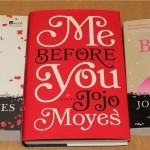 I’m on a Jojo Moyes reading kick at the moment. I hadn’t heard of this British novelist until about a month ago when a writer friend recommended I read her novel Me Before You (thank you EC Sheedy). I get lots of reading recommendations. And I have a ‘to be read’ pile that deserves its own zip code. But Me Before You – a layered and thought-provoking love story – sounded interesting. Plus, it was available at the library and in hard cover (and I’m always looking for hard cover books to read on the elliptical) so I picked it up. I figured I’d read it, in fits and starts, when I went to the gym.
I’m on a Jojo Moyes reading kick at the moment. I hadn’t heard of this British novelist until about a month ago when a writer friend recommended I read her novel Me Before You (thank you EC Sheedy). I get lots of reading recommendations. And I have a ‘to be read’ pile that deserves its own zip code. But Me Before You – a layered and thought-provoking love story – sounded interesting. Plus, it was available at the library and in hard cover (and I’m always looking for hard cover books to read on the elliptical) so I picked it up. I figured I’d read it, in fits and starts, when I went to the gym.
It was a well-intentioned plan. But it failed. I read Me Before You in two days. I read it whenever and wherever I could (once when I was cooking dinner). When I wasn’t reading it, I was thinking about it. Or, more specifically, thinking about Louisa and Will. Me Before You made me laugh. It made me cry. And as soon as I finished, it made me go out and get another Jojo Moyes book.
What I’m reading right now:
At the Gym:
The Last Letter From Your Lover by Jojo Moyes
Beside the Bed:
Stitches by Anne Lamott
In the Tub:
The Storyteller by Jodi Picoult
Books read to date 2014: 14
January 29, 2014
Staying Alive While Walking My Way to ‘The End’
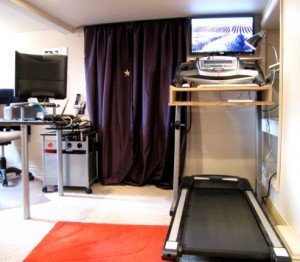 Driving home with the treadmill in the back of the SUV, I began to worry that I’d been overly optimistic about my ability to walk, write (and ideally think) at the same time. What if I couldn’t adjust to the thing? What if we’d gone to all this time and trouble and money and the treadmill ended up being a giant dust collector in the corner of my office?
Driving home with the treadmill in the back of the SUV, I began to worry that I’d been overly optimistic about my ability to walk, write (and ideally think) at the same time. What if I couldn’t adjust to the thing? What if we’d gone to all this time and trouble and money and the treadmill ended up being a giant dust collector in the corner of my office?
My worries were unfounded. I adjusted very quickly. It took me a couple of days to get over my nervousness that I’d fall, and to feel comfortable walking and typing (and thinking) at the same time. Before long, however, I found the 1 mph speed too slow; I routinely walk now at 1.5 to 2 mph. I also incline the tread a couple of notches as this gives me a more natural feeling step.
My goal is to use the treadmill four or maybe even five hours a day. Currently I’m up to three hours a day, alternating each hour with my sit down desk. After several months of this, I can honestly say I’m more productive on the treadmill than when I sit down. I’m less inclined to surf or check email. I’m more focused on what I’m writing. There’s something about moving the body that makes my mind move too (It seems to me there have been studies backing that up).
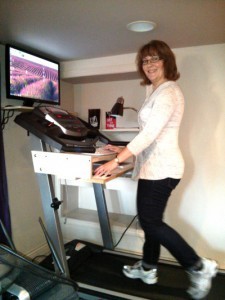 I like the treadmill best when I’m doing fresh writing or when I don’t have to look through books or papers for information. If I’m writing an article with lots of sources or if I’m on the phone or searching through books, it’s easier to sit with material spread out beside me. But when I’m writing manuscripts or blogs (like this one), walking seems to help the process. I even did a substantial revision for The Art of Getting Stared At while walking and that worked well.
I like the treadmill best when I’m doing fresh writing or when I don’t have to look through books or papers for information. If I’m writing an article with lots of sources or if I’m on the phone or searching through books, it’s easier to sit with material spread out beside me. But when I’m writing manuscripts or blogs (like this one), walking seems to help the process. I even did a substantial revision for The Art of Getting Stared At while walking and that worked well.
I couldn’t have set this up on my own. Mr. Petrol Head did the hard stuff and made it work. Here are some tips:
Make sure the floor is level before you get the treadmill. If it’s not, level it out.
To make the adjustment easy on my eyes, we set the treadmill monitor the same distance away as it is at my sit-down desk. This is less of an issue if you’re only using a treadmill desk but because I move from one station to another and I wear glasses when I work, this was important. We could have wall mounted the monitor but we had brackets and shelving on hand so we used them.
We used the same method (examining my position at my sit down desk) to determine the correct keyboard height. Because I hold a lot of tension in my shoulders, I was worried that typing standing up would be unnatural and cause me shoulder pain. I also wanted the option of having my mouse even lower. Mr. Petrol Head built two shelves just below the treadmill arms and attached them to the treadmill frame. He temporarily clamped them in place so I could try out the height for a few weeks. When I was sure the height was right, he drilled through the frame of the treadmill (being careful not to cut through any wires) and bolted the shelves into place. Now that I’m used to things I keep my mouse on the same shelf as my keyboard and use the lower shelf for books and papers.
I run two monitors from one desk top computer. I plug and unplug each one as needed. I use the same keyboard and mouse, and simply move both when I move.
Lighting and functionality. I have a combination of recessed pot lights and spot lights in my office and none were well-positioned to light the treadmill keyboard. I got around this with a gooseneck desk lamp that I clamped to a nearby shelf. Those nearby shelves have also aided significantly in functionality. I can leave my water bottle within easy reach, or the phone if I’m expecting a call. In a pinch I can put papers on them too.
One last suggestion – wear decent shoes. I had sore feet after the second week so I invested in a good pair of walking runners that live in my office and are dedicated for the treadmill. I also remember to stay hydrated (which might be another reason my focus has improved).
January 22, 2014
Walking My Way to ‘The End’
 I’ve wanted a treadmill desk for years. Writing books requires a lot of sitting, and though I go to the gym regularly, do yoga, and walk Team Sheltie daily, that sitting wasn’t doing me any good. I could feel it in stiff hips at the end of the day. I could see it as my pants got tight. With a family history of heart disease, obesity and diabetes (both my mother and my grandmother) getting off my butt was a priority. Each passing birthday seemed to underscore my slowing metabolism and my need to increase my activity level. Yet I needed – wanted – to keep writing.
I’ve wanted a treadmill desk for years. Writing books requires a lot of sitting, and though I go to the gym regularly, do yoga, and walk Team Sheltie daily, that sitting wasn’t doing me any good. I could feel it in stiff hips at the end of the day. I could see it as my pants got tight. With a family history of heart disease, obesity and diabetes (both my mother and my grandmother) getting off my butt was a priority. Each passing birthday seemed to underscore my slowing metabolism and my need to increase my activity level. Yet I needed – wanted – to keep writing.
I tried standing up to work for a while. It was incredibly fatiguing and my low back didn’t like it. A treadmill desk seemed a wise solution. Since I read on both the elliptical and stationary bike at the gym, I didn’t think I’d have trouble adjusting to moving and typing.
I started looking at manufactured treadmill desks, but my budget was low and they were expensive so that option was out. Unfortunately the budget wasn’t the only thing that was low. I also have a low ceiling.
My office is in the basement. It’s a lovely L-shaped room with charming nooks, a little bay window with an upholstered window seat overlooking my herb garden. But it’s a small space with a ceiling clearance of about six feet. Treadmills have a base anywhere from five to eight inches off the ground before you step onto the walking surface and I’m 5’4”. That meant finding a low height treadmill with a reasonably compact set up. I needed it to fit into my office in such a way that my existing desk remained. I wasn’t sure how I’d adapt and given that I work for about seven hours a day, I wanted the option of toggling back and forth between two work stations. That also meant two monitors, possibly two keyboards as well. As the potential costs and complications ratcheted up, my enthusiasm and determination plummeted.
Enter Mr. Petrol Head AKA The Man I Married who not only loves cars but also loves a challenge. And he yields a mean hammer. He built my window seat and he took it upon himself to figure out a way we could make a treadmill desk work.
He measured and mulled, finally concluding that we could squeak one in if I would move my existing sit-down desk closer to the window seat, if I was willing to buy a low height treadmill, and if I could find one with arms that were short, straight and wouldn’t get in the way of a keyboard (not as easy as you might think).
After a lot of on line research and in person looking at new and used models (and passing on several too-big Nordic Tracks which I seriously coveted), we decided on a mid-range Tempo model from Canadian Tire. The bottom-of-line line model seemed too flimsy and the high end version had bells and whistles I didn’t need. I began saving my pennies and went to work relocating my sit-down desk. At the same time, a good friend switched from a PC to a MAC and she sold me (for a ridiculously low price) her (nearly new) monitor, keyboard and mouse. Thank you, Lea Tassie. My long-held dream was close.
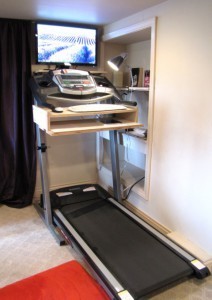 A few weeks before we were going to purchase the new treadmill, the same model showed up on Used Victoria. It was a year old and had been used maybe a dozen times (funny, that nearly new trend was rampant in virtually all the used treadmills we looked at). We hustled out to take a look. It was just what I wanted. Same model and in beautiful shape. I was ecstatic. “We’ll take it,” I told the seller though a niggle of doubt crept into my mind. It looked a LOT bigger by itself than it did in the store beside all the other behemoths.
A few weeks before we were going to purchase the new treadmill, the same model showed up on Used Victoria. It was a year old and had been used maybe a dozen times (funny, that nearly new trend was rampant in virtually all the used treadmills we looked at). We hustled out to take a look. It was just what I wanted. Same model and in beautiful shape. I was ecstatic. “We’ll take it,” I told the seller though a niggle of doubt crept into my mind. It looked a LOT bigger by itself than it did in the store beside all the other behemoths.
“Get on,” the seller urged.
So I did. I stepped onto it, raised my arms like I was typing, and I stared straight ahead at a monitor position. They turned it on. And I almost fell off. “Slow it down.” I grabbed the arms and steadied myself. “I need it on the lowest possible speed if I’m going to be able to work on this thing.”
The seller looked at Mr. Petrol Head. Mr. Petrol Head looked at me. “It’s on the lowest possible setting,” he said. “It doesn’t get any lower than this.”
I didn’t believe him. (Mr. Petrol Head lies). He wasn’t lying then. It was on the lowest setting. It was also destined to be ours. We brought it home that afternoon.
Next week: how we set it up and how it’s working.
January 15, 2014
A Blog a Day Keeps Boredom Away
 When I lost my email connection last week, it reinforced how much I rely on email, and, in particular, how much I look forward to the automatic arrival of several blogs I’ve signed up to receive.
When I lost my email connection last week, it reinforced how much I rely on email, and, in particular, how much I look forward to the automatic arrival of several blogs I’ve signed up to receive.
Given that we were buffeted by gale force winds and heavy rain, I expected a power outage. I pulled out some candles, brought in wood for the fire, backed up obsessively and hunkered down. The wind blew for days it seemed, but the lights – and my computer – stayed on. We made a pot of Mulligatawny soup, reminded ourselves that it was January and, considering what our friends and relatives to the east were experiencing, we were just fine.
A few days later, my email stopped. Nothing came in or went out for more than a day. When it came back up, it was sporadic at best for another twelve hours. It had nothing to do with the weather; it was an issue with my service provider. I wasn’t the only one with the problem either according to the live (and cranky) tweets on their site. Luckily I have a second email address on a different server so I quickly fired off emails to a couple of editors to let them know I was still at the keyboard.
All was fine. Until Passive Guy didn’t show up in my inbox as he usually does. Nor did Writer Unboxed or Live, Write, Thrive.
I survived. In the same way I’ll survive when door-to-door mail service stops a few years from now. But the thing is, I like hearing that metallic slam of my mailbox when the letter carrier brings news (even if Team Sheltie doesn’t). I love the ping of email hitting my in box. I’ve gotten attached to some great writing blogs too. I don’t need to subscribe – I know that – but I happen to like home delivery. Half the time if I don’t sign up, I forget to pop over and check things out. Here are a few of my favorites:
The Passive Voice http://www.thepassivevoice.com/ Subscribe and receive a daily round up of publishing news and views from the Passive Guy. It hits my in box every day around lunch and I usually read it while I eat my salad.
Writer UnBoxed http://writerunboxed.com/ is there when I first check email in the morning and I read it with my first cup of coffee. What I love about this blog is the range – a different writer every day and a ton of different topics.
Live, Write, Thrive http://www.livewritethrive.com/ Another early morning arrival and becoming a favorite. Posts by author/editor C.S. Lakin who publishes both traditionally and independently in e and audio form. Great blend of craft, business and all round inspiration.
There are other blogs I love too:
Chuck Wendig’s http://terribleminds.com/
Rachelle Gardner’s Books & Such Blog: http://www.rachellegardner.com/
The always informative Kristine Kathryn Rusch: http://kriswrites.com/
And last but not least: http://writersinnerjourney.com/
What writing blogs are on your must read list?
January 8, 2014
A Most Bookish New Year
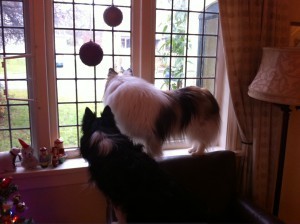 Actually, it was a bookish Christmas at our house. That’s nothing out of the ordinary. I tend to give – and receive – books for Christmas. I scored big-time this year with new titles by Kristan Higgins, Lisa Gardner, Jodi Picoult, and Anne Lamott. Once Christmas was over (and it was a doozy this year with two very sick dogs,though they were well enough to watch out the window as the company left), I settled in to read. It occurred to me that I should set myself an annual reading goal – say two books a week, which is an easy target for me. Ultimately I decided against it. I’m stretching myself with some extra writing goals this year. Reading is my reward; I don’t want to turn it into a ‘should.’ Having said that, I am going to track the number of books I read over the next twelve months. I’m curious to see if I read as much as I think I do. Here’s what I’m reading right now:
Actually, it was a bookish Christmas at our house. That’s nothing out of the ordinary. I tend to give – and receive – books for Christmas. I scored big-time this year with new titles by Kristan Higgins, Lisa Gardner, Jodi Picoult, and Anne Lamott. Once Christmas was over (and it was a doozy this year with two very sick dogs,though they were well enough to watch out the window as the company left), I settled in to read. It occurred to me that I should set myself an annual reading goal – say two books a week, which is an easy target for me. Ultimately I decided against it. I’m stretching myself with some extra writing goals this year. Reading is my reward; I don’t want to turn it into a ‘should.’ Having said that, I am going to track the number of books I read over the next twelve months. I’m curious to see if I read as much as I think I do. Here’s what I’m reading right now:
At the Gym:
The First Phone Call From Heaven by Mitch Albom
Beside the Bed:
The Perfect Match by Kristan Higgins
On the Kindle:
Man For Grace by EC Sheedy
Books read to date 2014: 4
December 21, 2013
Vic Bosson and Another Digital Picture Book Release
Thanks to Crow Cottage Publishing The Magic Ear is now available in a digital and audio enhanced form. The talented Vic Bosson did the art for this picture book, which was originally released in 1995, as well as the art for The Fox’s Kettle. Both books are Japanese-inspired folk tales and Vic’s beautiful art played a significant role in their initial success. The Magic Ear can be purchased here: https://itunes.apple.com/us/book/the-magic-ear/id766073187?ls=1&mt=11
Since illustrators don’t get nearly the credit they deserve I asked Vic to take the spotlight on this week’s blog.
Vic, you’ve been fascinated by Japan for many years. Why?
 It started in childhood. My mother collected small Japanese sculptural pieces that were always on the mantle. I’d look at them and imagine who these characters were, and I’d invent stories around them. When I got to Art College I realized the sculptures that had interested me earlier were showing up in reference books. I was also exposed to European artists of the 19th century whose work reflected some of the Japanese wood block prints being imported around that time. All of these things influenced my work and it evolved into a blend of Japanese and Western art. I travelled to Japan three times too and that inspired me further.
It started in childhood. My mother collected small Japanese sculptural pieces that were always on the mantle. I’d look at them and imagine who these characters were, and I’d invent stories around them. When I got to Art College I realized the sculptures that had interested me earlier were showing up in reference books. I was also exposed to European artists of the 19th century whose work reflected some of the Japanese wood block prints being imported around that time. All of these things influenced my work and it evolved into a blend of Japanese and Western art. I travelled to Japan three times too and that inspired me further.
The Fox’s Kettle was the first of the two Japanese folk tales to be released digitally. What was your first reaction when you were approached to release it as an e book?
I thought what a perfect way to expose a new group of people to the story. And because the art for The Fox’s Kettle was originally designed on the computer, it had a different light quality, almost like a stained glass window effect, that you don’t get in a traditional book. I thought it would reproduce in e form beautifully.
So were the files ready to go when you got the call?
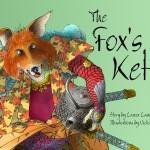 No. Because it was produced originally in a traditional form, the proportions were markedly different and sat on the page differently. I had to rescale everything and fit it on the page size specified. Same for the text. We treated it as another graphic element. So even though the images existed prior to the e book, there was an incredibly large amount of work to do changing from traditional to electronic form.
No. Because it was produced originally in a traditional form, the proportions were markedly different and sat on the page differently. I had to rescale everything and fit it on the page size specified. Same for the text. We treated it as another graphic element. So even though the images existed prior to the e book, there was an incredibly large amount of work to do changing from traditional to electronic form.
The Magic Ear was a completely different experience in that it was originally done by hand. How did you go about readying it for digital form?
The images for that book were originally water color and pencil crayon on water color paper. And there were borders for each page too – hand cut from Japanese washi paper and meticulously glued together. Readying the digital version was extremely time-consuming. I went with the published book images but because they’d been done originally as four color separations, I had to go back in and repaint all the images digitally. Then, when I tried to scan the borders from the book, they looked mushy so I had to go in and redo all of those electronically too. There was a huge time commitment going from print to digital on The Magic Ear but I like having a hands on approach and I wanted the finished product to be as good as it can be.
Almost all of your art is produced digitally now. Do you see this as the natural evolution of art or do you think there is a place for multiple methods?
I strongly believe that digital creation is a tool in the same way that a brush or a pencil is a tool. Whether you’re creating with a pencil or with a computer, the tool doesn’t do the job for you. People sometimes forget that. They seem to think if something is generated on a computer, the computer does all the work. It can’t do that anymore than a brush can paint a picture. The artist does the work.
In terms of traditional versus digital art, I think there will always be room for both. There are limitations in traditional materials and also in electronic form. In electronic, it’s scale – it’s hard to produce a digital piece that’s twenty feet long. You have to rethink what you’ll do with the image and what venue you’ll show it in. Trying to blow up a regular digital image to say, twenty feet, would look terrible. On the other hand, if you have a large, complex painting and you shrink it down, you lose detail. So there are pros and cons for both.
When a book is produced to be released as an e book only, do you think it makes more sense to do the art in digital form from the get go?
I personally think so, but on the other hand, there aren’t many artists doing digital work. It’s very rare that illustrators or artists concentrate on doing things electronically.
What are you working on now?
I’m working with a 3-d modelling illustration program. It’s like making a movie – you create the characters, whether they’re human or not, create a landscape, houses, that kind of thing. You model it all three dimensionally. You have a choice of how you light it too, and it can be produced as a painting or you can utilize a series of stills that can make up an animated film.
It sounds amazing.
It is, but it’s a real time suck and the learning curve is fairly steep. But because I was a sculpture major, the idea of creating with this level of depth is wonderful. It’s like being God. I’ve done two pieces that I turned out as 2D work and I had a great time and people enjoyed them so that’s encouraging.
If someone tells you they’re going to follow their passion and be an artist full time for life what three pieces of advice would you give them?
Spend ten thousand hours and learn how to draw.
Develop your skills so that you stand out in the crowd in your chosen field of art.
After many years of developing skills in several disciplines, make sure you know what field of art you’re suited to.
If you hadn’t been an artist, what would you have been?
I like design and sculpture so I think I would have gone into architecture or automotive design, not just cars but things that move.
Your family has an opportunity to describe you for a profile piece. What six words would they say describe you best?
Digital artist who loves satire and folklore.
Thank you, Vic!
Vic Bosson is a graduate of the Alberta College of Art and has been making innovative artworks for over 40 years. In 1984, Bosson’s deep interest in design and narrative art motivated him to utilize state-of-the-art computer systems to execute new ideas in art making. To see more of Victor’s work, visit his site on ETSY: http://www.etsy.com/shop/galleryartlife
December 17, 2013
More Gifts of the Season
 Happy holidays everyone! Winter solstice is almost here. Soon it’ll be Christmas and then it’ll be time to turn the calendar on another year. Over the next while, many of us will gather with friends and family to celebrate with music, food, laughter and gifts. Last week I shared some of the memorable writing-related gifts I’ve received . . . and a few other authors added their memories too. Today, another ten authors tell us about their favorite writing-related gifts.
Happy holidays everyone! Winter solstice is almost here. Soon it’ll be Christmas and then it’ll be time to turn the calendar on another year. Over the next while, many of us will gather with friends and family to celebrate with music, food, laughter and gifts. Last week I shared some of the memorable writing-related gifts I’ve received . . . and a few other authors added their memories too. Today, another ten authors tell us about their favorite writing-related gifts.
Monique Polak: “My best writing gift ever is a little blue glass statue of Ganesh, the Hindu elephant-headed god. My dear friend and fellow children’s author Rina Singh gave me the statue many years ago when I was trying and trying to sell my first manuscripts — and not succeeding. Rina explained that Ganesh is believed to help people overcome obstacles. The little statue worked for me — I finally sold my first manuscript and have gone on to publish 13 more. (It also helped, I think, that I didn’t give up along the way.)” Monique Polak is the author of So Much it Hurts (Orca Book Publishers) www.moniquepolak.com Rina Singh is the author of Guru Nanak (Groundwood).
Ann Walsh: “When I was writing my first novel (Your Time, My Time) at the kitchen table on a noisy manual typewriter, my oldest daughter would come home from school and demand to see the new pages. Later, I hired her to proof-read the manuscript, paying $.25 for every mistake she found. As I recall, we argued over a lot of commas.
When the book was finally published, she was in high school. One night I woke in the small hours to the sound of weeping. A teen-aged daughter crying in the middle of the night is a sound no mother ever wants to hear. Before I even reached her bedroom, dozens of dreadful scenarios had flashed through my mind.
“Katie, what’s wrong? What happened? Are you all right?”
She was clutching a copy of Your Time, My Time and a handful of kleenex. “It’s so sad, Mum.”
Even though she had helped birth the book and knew it almost as well as I did, it moved her to tears. A writing gift beyond price.” Ann Walsh is the author of Whatever (Ronsdale Press) http://annwalsh.ca/
 Joan Marie Galat: “I often write about the stars but I also seem to be trying to reach them! My favourite writing-related gift is a pair of stilt-walking pants, sewn by a friend. Since learning how to walk on stilts (which increases my height to more than eight feet), I plan to use my new skill to encourage reading and writing. These alphabet-themed pants, made from a duvet cover, form part of my costume as I prepare to promote the theme: Stand Up for Literacy! “ Joan Marie Galat’s latest title is the award-winning The Discovery of Longitude (Pelican Publishing Company) www.joangalat.com
Joan Marie Galat: “I often write about the stars but I also seem to be trying to reach them! My favourite writing-related gift is a pair of stilt-walking pants, sewn by a friend. Since learning how to walk on stilts (which increases my height to more than eight feet), I plan to use my new skill to encourage reading and writing. These alphabet-themed pants, made from a duvet cover, form part of my costume as I prepare to promote the theme: Stand Up for Literacy! “ Joan Marie Galat’s latest title is the award-winning The Discovery of Longitude (Pelican Publishing Company) www.joangalat.com
Eileen Kernaghan: “My favourite writing gift was the typewriter my parents gave me as a Christmas present when I was eleven. As soon as I’d mastered a two-fingered keyboard technique I sent a children’s story to the Vancouver Sun, which to everyone’s astonishment was accepted. Then, since my long-term ambition was to be a journalist, I became the Grindrod stringer for the weekly Enderby Commoner (the masthead said “covers the valley like the dew”). My assignment was to report the births, deaths, anniversaries, out of town visitors and other important local events in our farming village, pop. 600. I was too shy at twelve to interview people, so my mother did the actual research — having a party line helped — and I wrote it all up. I never did learn touch typing, but as far as writing was concerned, I never looked back.” Eileen Kernaghan is the author of the YA historical fantasy Sophie, in Shadow (Thistledown April 2014). www.eileenkernaghan.ca
Kent Rees: “In a word, the best writing gift I have ever received was inspiration.” Kent Rees is the author of Molly Withers and the Golden Tree (Amazon.com) www.mollywithers.com
Ellen S. Jaffe: “The best writing gift I ever received was the funds from my parents to attend Breadloaf Writers Conference in Vermont in 1964, when I was 19; I grew up in New York and was attending college in Masschusetts.
My application to Breadloaf was accepted and my family made it possible for me to go. I can’t remember the cost, though I’m sure it was substantially lower (more than 50%) than today’s fees. Being surrounded and mentored by well-known writers, and getting to know published writing “fellows” as well as younger people like myself, helped me begin to feel like a writer and to be “naked in public,” although I had been writing stories and poems since childhood. I have continued on that path, winding my way and sometimes getting lost temporarily, for almost 50 years.” Ellen S. Jaffe is the author of Skinny-Dipping with the Muse, (Guernica, spring 2014)www.ellen-s-jaffe.com
Silvana Goldemberg: “Beside the little gift of writing I got from my writer mom, my writing gift came from destiny: the ONLY time I won a draw in my life it was in grade 5 and the prize was a box with a Parker fountain pen. Since then, I haven’t stopped writing.” Silvana Goldemberg is the author of many books in Spanish and “Victoria” (Tradewind, 2013) is her first book in English. http://bcbooklook.com/2013/12/12/dont-cry-for-me-argen-teena/
Marilyn Helmer: “Early in my writing career, our local newspaper held a short story contest. At that point, the few short stories and poems I had submitted to children’s magazines had met with little success. My dream of becoming a published author was looking bleak. So why not try writing a short story for adults? To my surprise and delight, my story, “Home For the Holidays”, won first prize – a brand new home computer system. Not only did the computer with its various programs and software make the writing process so much easier, it was the incentive I needed to renew my determination to be a published author. I have realized that dream many times over and can honestly say that that computer was definitely the best writing gift I ever received.” Marilyn Helmer is the author of The Great Garage Sale and Pirate Island Treasure (Orca) www.marilynhelmer.com
Dani Collins: “My favorite gift was a whiteboard from my husband. (4 x 5’) I caught him on my lunch hour trying to buy wine glasses for my birthday, but we already had a set that I liked. I said I’d really prefer a whiteboard. We walked across the street to the store and it was hanging on my office wall when I got home from work. LOVE IT.” Dani Collins is the author of More Than a Convenient Marriage? December Harlequin Presents. www.danicollins.com
Ellen Schwartz: “The best writing gift I ever received was the gift of time. I’ve always found it hard to get down to work on a book at home. Kids, laundry, phone, other writing work (read: paying work), husband, dog… Several years ago, our friends James and Lynn Hill, said, “Why don’t you go up to our place in Whistler? We’re hardly ever there. You could have the place to yourself.” So I did. Fearfully, with trepidation. Because: What if, after all those years of complaining about how I couldn’t concentrate at home, now that I had peace and solitude, I couldn’t write? I needn’t have worried. I got up to the townhouse, unpacked the coffee and the wine, propped my writing clipboard on my lap – and wrote. And wrote. For years, not just the Hills but other generous friends have given me the use of their homes while they’re away, and I’ve written most of my last ten books in these getaways. Now, later in my career, I’m trying something new: writing at home. And you know what? I can do it. (But I’d rather be in Whistler.)” Ellen Schwartz is the author of The Case of the Missing Deed (Tundra; winner of the 2013 Rocky Mountain Book Award) www.ellenschwartz.net
Merry Christmas and Happy New Year everybody!
December 11, 2013
Gifts of the Season
 Winter solstice. Hanukkah. Christmas. Winter’s celebratory season is here and for many that means gifts. Gifts given and gifts received. I’ve received many wonderful writing-related gifts through the years: beautiful pens, lovely calendars, a leather briefcase. One of my most memorable writing-related gifts was from my grandmother. Just before she died, she introduced me in a whisper to one of the hospice nurses as ‘my granddaughter who writes books.’ I hadn’t written my first book yet, though I wanted to. Her unwavering belief that I could do it was a gift that carried me until I wrote and sold my first novel. Whether they’re intangible or lovely and practical, gifts specific to writers cover the gamut. Here a number of other writers share some of the special gifts they’ve received.
Winter solstice. Hanukkah. Christmas. Winter’s celebratory season is here and for many that means gifts. Gifts given and gifts received. I’ve received many wonderful writing-related gifts through the years: beautiful pens, lovely calendars, a leather briefcase. One of my most memorable writing-related gifts was from my grandmother. Just before she died, she introduced me in a whisper to one of the hospice nurses as ‘my granddaughter who writes books.’ I hadn’t written my first book yet, though I wanted to. Her unwavering belief that I could do it was a gift that carried me until I wrote and sold my first novel. Whether they’re intangible or lovely and practical, gifts specific to writers cover the gamut. Here a number of other writers share some of the special gifts they’ve received.
Karen Autio: “At the 2002 BC Festival of the Arts I met fellow delegates from around BC–all children’s writers–and we formed an email group. Five of us continue to correspond regularly, critique each other’s work, and get together as often as we can. Having their support, insights, and encouragement is my best writing gift. Truly priceless.” Karen Autio is the author of “Sabotage” (Sono Nis Press) www.karenautio.com
Irene Watts: “A few years ago my granddaughter Rebecca gave me a journal, bound in real leather, with my name in gold letters inscribed on the cover. At the time I was going through a dry spell between books. Inside she had written, Happy Writing, and whether it was that or the feel and smell of the leather and the way the journal felt in my hands, but it became filled with ideas for a new book.” Irene Watts is the author of Touched by Fire and the Omnibus, Escape From Berlin. (Tundra) http://www.irenenwatts.com/author.html
Helen Mason: “The best writing gift I ever received was a copy of The Reader’s Encyclopedia (New York: Thomas Y Crowell Company, 1955). The gift was from my Aunt Marg, who was a high school English teacher. This gift reinforced my interest in language and showed me that she thought I was interested in it. Before the Internet, it was also a useful reference that saved me hours of research. I still have it on my reference shelf, even though I haven’t used it in years. It’s a symbol of my aunt’s confidence in and love of me.” Helen Mason is the author of Weird Nature and Agricultural Inventions: At the Top of the Field (Crabtree)
Caroline Woodward: “I used to write unselfconsciously in high school, one draft wonders, really. I even wrote a weekly column for two years and did special “youth” assignments for the Alaska Highway News. Not bad work for 75 cents by the line inch in 1968–70. Then came university and struggling with Paradise Lost for three months in honours English. My writing style clumped, clotted and clanked, unsure of itself, let’s be honest, my writing was a turgid pudding, festooned with ibids and opcits, and I was a writer afraid of emitting an original thought unless some dead guy had okayed it first.
But I kept at it, reading voraciously and writing sporadically, because it was my only hope of synthesizing my own life experience, of living an examined life. I wrote in isolation, working as a caretaker and gardener and substitute teacher and other jobs which allowed me time to hole up somewhere and write. But I lacked real confidence and mentors and a savvy, supportive writing community. Finally, I attended one glorious year of writing school in Nelson, BC, where real writers taught us and where visiting writers dropped in to read to us and to give workshops in nearly all genres. I discovered contemporary Canadian magazines. I played with form, tinkering with my backlog of content, still feeling like a prissy Victorian governess was in control of my writing until one day Paulette Jiles, poet and friend circa 1985, said to me: “Why don’t you write like you talk?” It’s the best writing advice I’ve ever had. Whenever I battle my perfectionist self to a standstill, I haul it out and remind myself that I have a distinctive voice and many more stories to tell!” Caroline Woodward is the author of“The Village of Many Hats” (Oolichan Books: 2012) www.carolinewoodward.ca
Leigh Carter: “The best writing gift I ever received was a blackboard, coloured and white chalk and an eraser so that I could ‘play’ school with my dolls. I was about 8, and it was what made me want to write, and to try to encourage others (my dolls) to feel the same as I did about words.” Leigh Carter is a senior corporate communications manager and freelance editor/proof reader.
Fiona McQuarrie: “The best writing gift I ever received was feedback from people who were honest enough to tell me when it could be better, and kind enough to show me how it could get there.” Fiona McQuarrie is the author of Industrial Relations in Canada (Wiley). www.allaboutwork.org
Lee Edward Fodi: “I think one of the best writing gifts I ever received was a thesaurus for my eleventh birthday from my best friend. He knew at that time I wanted to be a writer, and so he gave me quite a serious gift (not what you would typically expect one eleven-year-old boy to give to another). And, of course, this was before the time of computers and electronic dictionaries. It was a gift I actually needed, as we didn’t have a thesaurus in our house. I still have the thesaurus.” Lee Edward Fodi is the author of the Kendra Kandlestar series including Kendra Kandlestar and the Box of Whispers (Simply Read Books). www.leefodi.com
Gisela Sherman: “Many years ago when I was a teacher, and first dating my now husband, I found it hard to tell him my secret dream of becoming a writer. Would he think I was crazy? Would he like the stories I was writing out in longhand every chance I got? A month later on my birthday, he showed me his support - my own electric typewriter, the latest technology at the time. As I happily typed out my stories and articles, I knew he was the man for me.” Gisela Sherman is the author of Snake In My Toilet (HIP Books, April 2014) and a past president of CANSCAIP (The Canadian Society of Children’s Authors, Illustrators and Performers).
Nikki Tate: “Hands down, the best gift for me is some time to get away and focus on writing. Running a small, mixed farm, this is NOT an easy thing to accomplish. I am SO grateful to friends and family who have, over the years, stepped in to handle tasks ranging from goat milking to turkey wrangling to poop shovelling so I could slip away, hole up, and just write!” Nikki Tate is the author of Down to Earth: How Kids Help Feed the World (Orca) www.nikkitate.com
Sylvia McNicoll: “The best writing present I ever received was probably in 1999 (exact date is fuzzy) when my husband took it upon himself to create a website for me. No one had one in those days. As a computer programmer he didn’t know anything about design but he knew me and my books and proceeded on his own. Even back then writers wanted to work on their books not on promotion so I really appreciated the fact he didn’t bother me about content. The finished product was beautiful and the Quill and Quire wrote an article talking about the three (I think) authors who had one, me being one. Ironically the tool of promotion became an object which was promoted. Since then I’ve had several redesigns by visual artists but none with as much impact as that first.” Sylvia McNicoll is the author of Dying to Go Viral (Fitzhenry) www.sylviamcnicoll.com
Come back next week for more of our favorite writing-related gifts.



